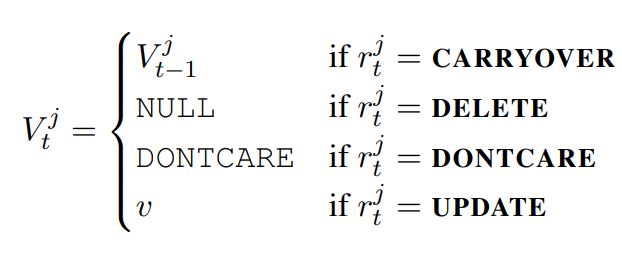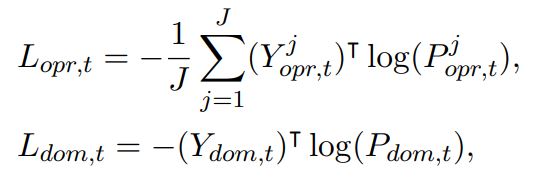[Paper Review] Efficient dialogue state tracking by selectively overwriting memory
Efficient dialogue state tracking by selectively overwriting memory
Kim, Sungdong, et al. “Efficient dialogue state tracking by selectively overwriting memory.” arXiv preprint arXiv:1911.03906 (2019).
Abstract
dialogue state tracking (DST)에서 기존 미리 정의된 ontology 기반 접근법의 확장성과 일반화 문제를 해결하기 위해, 최근 연구들은 open-vocabulary-based setting에 초점을 두고 있음
하지만, 최근 연구들은 처음부터 끝까지 모든 turn의 대화 상태(dialogue state)를 예측한다는 점에서 비효율적이라는 문제가 있음
본 논문에서는 dialogue state를 명시적인 고정 크기의 메모리로 간주하고, 효율적인 DST를 위한 선택적 overwriting mechanism을 제안함
-
논문에서 제안한 메커니즘
-
각 memory slots에 대한 state operation 예측
-
예측된 state operations에 따라 생성이 필요한 slot에 한하여 생성하고, memory를 새로운 value로 overwriting 수행
-
또한, 논문에서는 DST를 2개의 sub-task로 나누었고, 정확한 역할 분담으로 decoder가 생성에만 집중할 수 있도록 하여 부담을 덜어줌
이는 학습의 효율성과 DST의 성능을 향상시킴
-
SOM-DST 성능
- open vocabulary-based DST setting에서 MultiWOZ 2.1에서 53.01% MultiWOZ 2.0에서 51.72%의 joint goal accuracy로 SOTA 달성
Selectively Overwriting Memory for Dialogue State Tracking
Dialogue State
논문에서는 대화 turn t에서의 dialogue state를 ${B_{t} = \lbrace (S^j,V^j_t) | 1 \le j \le J \rbrace}$ 로 표기하고, slot S가 key이고 그에 해당하는 V가 value인 고정된 사이즈의 메모리로 간주
여기에서 J는 slots의 전체 개수
MultiWOZ 20.과 MultiWOZ 2.1의 관행을 따라 논문에서 domain 명과 slot 명의 concatenation을 “slot”으로 사용
Special Value
special value인 NULL, DONCARE를 사용
-
NULL : turn에서 slot에 대한 정보가 없음을 의미하는 값
ex) 대화가 시작되기 전에 dialogue $B_{0}$는 모든 slot의 value 값으로 NULL을 가짐
-
DONCARE : 대화에서 더이상 추적할 필요가 없거나 중요치 않은 값을 나타낼 때 사용
Operation
모든 turn t에서 state operation predictor에 의해 연산이 선택됨
operations : CARRYOVER, DELETE, DONCARE, UPDATE
현재 turn에 해당하는 모든 slot $S^j$의 value $V_{t}^t$를 설정하기 위해 연산을 수행
CARRYOVER인 경우에만 이전 value 값을 유지하고, 나머지 연산인 경우에는 변경됨
DELETE는 이전 value 삭제하고 NULL로 설정
DONCARE는 현재 value 값을 DONCARE로 설정
UPDATE는 현재 value 값을 새롭게 생성
state operation predictor는 classification task로 state operation prediction을 수행하고, slot value generator는 slots의 values를 찾기 위해 slot value 생성을 수행 (UPDATE 일 때만 생성)
-> 이 두가지 구성요소가 현재 turn의 dialogue state를 예측하기 위해 공동으로 학습됨
State Operation Predictor
Input Representation
turn t에서의 dialogue utterances를 ${D_t = A_t \oplus ; \oplus U_t \oplus [SEP]}$로 표기
A : system response
U : user utterance
; : A와 U를 구분해주는 스페셜 토큰
[SEP] : dialogue turn이 끝났음을 표시해주는 스페셜 토큰
turn t에서의 dialogue state를 ${B_t^j = [SLOT]^j \oplus S^j \oplus - \oplus V_t^j}$로 표기
[SLOT] : BERT의 [CLS] 토큰과 유사하게 j번째 슬롯 정보를 담는 스페셜 토큰
- : slot과 value를 구분해주는 스페셜 토큰
논문에서는 모든 slot j에 대한 스페셜 토큰으로 [SLOT]를 동일하게 사용
state operation predictor로 pre-trained BERT encoder 사용
input : 이전 turn dialog utterances, 현재 turn dialogue utterances, 이전 turn dialog state의 concatenation
$X_t = [CLS] \oplus D_{t-1} \oplus D_t \oplus B_{t-1}$
[CLS] 토큰은 모든 turn의 input의 앞에 붙는 스페셜 토큰이고, 입력으로 이전 대화 상태를 사용하는 것은 모델에게 명시적이고 압축된 유익한 정보를 주는 역할
input token $X_t$의 임베딩, segment id의 임베딩, position 임베딩으로 합이 BERT의 입력으로 들어감
segment embedding은 $D_{t-1}$에 속하는 토큰은 0으로 $D_t, B_{t-1}$에 속하는 토큰은 1로 설정
Encoder Output
encoder의 output representation은 시퀀스 정보를 인코딩한 $H_t$, [CLS] 토큰을 인코딩한 $h_t^{[CLS]}$, [SLOT] 토큰을 인코딩한 $h_t^{[SLOT]^j}$
[CLS] 벡터를 feed-forward layer에 통과시켜 전체 시퀀스 정보를 응축한 $h_t^{X}$를 얻을 수 있음
State Operation Prediction
인코더 output인 각 slot representation $h_t^{[SLOT]^j}$를 이용하여 four-way classification 수행
Slot Value Generator
j 번째 slot에 대해 해당하는 value를 생성하는 역할
기존의 slot value generator와 달리 J번 생성하는 방식이 아닌 필요한 경우에만 생성하는 방식으로 효율적인 계산이 가능함
Gated Recurrent Unit (GRU)를 사용하였고, hidden vector와 embedding vector를 encoder의 벡터값으로 초기화
[EOS] 토큰이 입력으로 들어올 때까지 재귀적으로 hidden state $g_t^{j,k}$를 업데이트
decoder 단계에서 hidden state는 vocabulary에 대한 확률분포로 변환됨
E : encoder, decoder가 공유하고 있는 word embedding matrix
value token 후보에 대한 최종적인 distribution을 얻기 위해, soft gated copy mechanism 사용
Objective Function
학습 시, state operation predictor와 slot value generator를 공동으로 최적화시켜야 함
State operation predictor
dialogue turn 사이의 slot operations과 domain transitions의 상관관계를 학습할 수 있도록 domain classification을 state operation classification의 보조 task로 사용함
-
domain classification
turn t에서의 domain 확률 분포를 예측하여 domain classification 수행 ()
negative log-likelihood 사용
Slot value generator
negative log-likelihood의 평균을 loss로 사용
최종적인 loss













Leave a comment